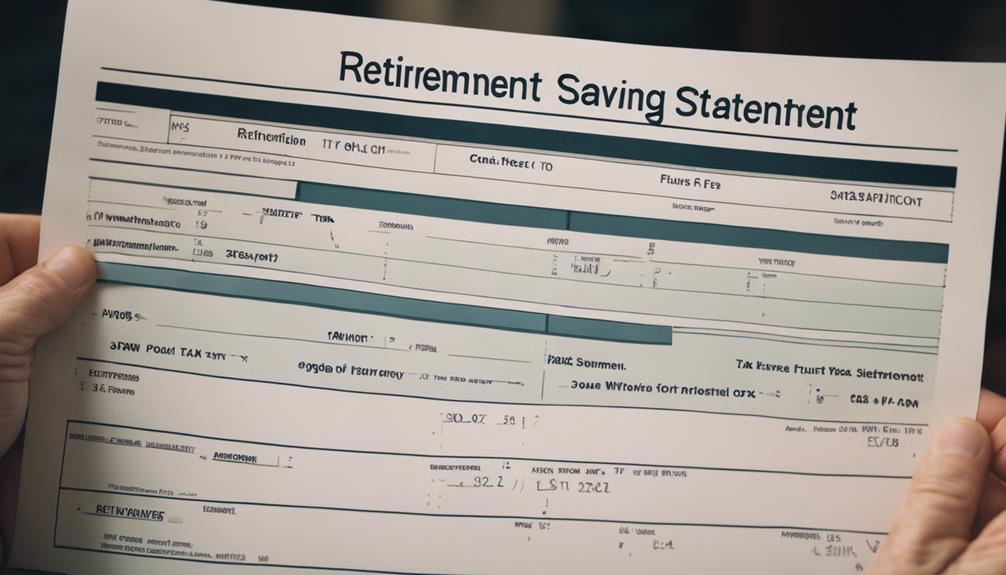Investing in gold for retirement can help protect against market volatility and inflation. Gold’s tendency to move in the opposite direction of stocks can lower overall portfolio risk, especially during times of economic uncertainty. There are different ways to invest in gold such as mutual funds, ETFs, and gold IRAs, each offering unique advantages. Tax implications vary, with physical gold typically taxed as collectibles. Potential risks include price fluctuations and limited diversification in gold IRAs. Seeking guidance from financial experts can help maximize the benefits of investing in gold based on your long-term financial objectives and manage potential risks. Explore more about the advantages and complexities of purchasing gold for retirement to safeguard your financial future.
Key Takeaways
- Consider gold IRAs for physical metal holdings in retirement savings.
- Evaluate tax implications of different gold investment options.
- Seek advice from financial advisors for tailored gold investment strategies.
- Be aware of risks like volatility and limited diversification with gold investments.
- Optimize returns by keeping administrative fees in Gold IRAs below 1%.
Benefits of Investing in Gold

Gold offers significant advantages as an investment for retirement planning, providing a reliable safeguard against inflation and market volatility. Including gold in a retirement portfolio can serve as a hedge against inflation, preserving purchasing power over time. Diversification is vital in retirement investing, and gold offers a negative correlation to stocks, reducing overall portfolio risk. During times of economic uncertainty, gold prices often rise, offering protection against currency devaluation and market instability.
Tax benefits also make gold investments attractive for retirement planning, with tax-free asset growth in retirement accounts until withdrawals are made. Gold IRAs provide an avenue for self-directed alternative investments, allowing individuals to hold physical precious metals within their retirement accounts. This diversification beyond traditional assets can offer stability and security in a retirement portfolio. Considering these benefits, incorporating gold into retirement investment strategies can be a wise decision for long-term financial security.
Types of Gold Investments

Exploring various avenues for investment diversification in retirement portfolios can lead to a better understanding of the options available beyond traditional assets. Gold mutual funds offer exposure to gold-related companies and industries, providing a way to include precious metals in a retirement portfolio.
Gold ETFs, whether passively or actively managed, offer a cost-effective means of investing in gold for retirement savings. Leveraged gold ETFs can amplify exposure to gold price movements without the necessity of owning physical gold.
Gold IRAs enable investors to hold physical gold, silver, platinum, and palladium as part of their retirement savings. When considering Gold IRAs, it is important to keep administrative fees below 1% to maximize investment returns.
Each type of gold investment presents unique advantages and considerations, allowing individuals to tailor their retirement portfolio to their specific preferences and financial goals. By exploring these options, investors can strategically incorporate precious metals into their retirement savings while aiming for long-term growth and diversification. For those interested in setting up a gold retirement, it’s essential to evaluate factors such as market trends, storage options, and associated fees to make informed decisions. Whether through physical gold ownership, gold-backed IRAs, or exchange-traded funds, each approach offers varying levels of control and risk. By carefully aligning their investment strategy with their retirement objectives, individuals can enhance their financial security while leveraging the enduring appeal of gold.
Tax Considerations for Gold Investments

When contemplating gold investments for retirement, it is essential to be aware of the tax implications associated with different types of gold investment vehicles. Understanding the tax treatments can help you make informed decisions about how to structure your investments.
Here are some key points to ponder:
- Physical gold investments are taxed as collectibles at a maximum rate of 28% by the IRS.
- Different types of gold investments may have varying tax treatments based on IRS regulations.
- Reflect on consulting a tax advisor to understand the specific tax implications before investing in gold.
- Roth gold IRAs require tax payments on contributions but offer tax-free withdrawals during retirement.
- Traditional gold IRAs funded with pre-tax contributions are taxed upon distribution in retirement.
Risks Associated With Gold for Retirement

Considering the financial uncertainties surrounding gold investments for retirement, it is essential to carefully assess the inherent risks associated with this asset class. Gold for retirement, while often seen as a safe haven, carries the risk of not generating earnings or dividends for long-term growth.
Investing in gold may not be ideal for wealth generation or consistent investment income, as its value can be volatile. Gold IRAs, which restrict holdings to IRS-approved gold assets, exclude items like jewelry or collectibles, limiting diversification options. Transferring retirement savings to a gold IRA can involve financial risks and considerations, such as transaction fees and potential tax implications.
When incorporating gold into a retirement portfolio allocation, it is important to consult with a financial advisor to ensure alignment with long-term investment goals. To mitigate risks and maximize returns, consider diversifying across various asset classes and seeking professional guidance to make well-informed decisions regarding gold for retirement.
Seeking Professional Guidance

Seeking professional guidance is essential when maneuvering through the complexities of investing in gold for retirement. A financial advisor can help investors navigate the various options available, guaranteeing that the chosen investments align with their retirement goals and risk tolerance. Here are five key ways in which seeking professional guidance can benefit individuals looking to invest in gold for their retirement portfolio:
- Financial advisors can provide tailored advice on whether to invest in gold stocks, physical gold, or gold coins.
- They can help investors understand how gold investments fit into a diversified portfolio and how much gold to hold.
- Professionals can offer insights on the tax implications of gold investments and suggest strategies to optimize returns.
- Seeking guidance from a fiduciary ensures that recommendations are made in the client's best interest.
- Experts can assist in comprehending the intricacies of including gold investments in retirement accounts like IRAs.
Frequently Asked Questions
What Is the Best Way to Invest in Gold for Retirement?
When considering gold investments for retirement, the best approach involves opening a self-directed IRA to include physical gold. This strategy allows for tax-advantaged growth while diversifying your portfolio.
Research IRS-approved gold options like bullion or coins and seek advice from financial advisors to tailor the investment to your retirement goals.
Combining gold with traditional assets can provide a balanced approach to long-term wealth accumulation and preservation.
How Much Gold Do I Need to Retire?
Determining the ideal amount of gold needed for retirement hinges on individual factors such as investment goals and risk tolerance. Financial advisors often recommend allocating 5-10% of your portfolio to gold for diversification.
As retirement approaches, adjusting this allocation can help manage risk and protect wealth. Consulting with a financial advisor is essential to tailor the gold allocation to your specific retirement needs, ensuring a well-rounded and resilient portfolio.
Should I Buy Gold Coins or Bars?
When deciding between buying gold coins or bars for retirement, consider your investment goals and preferences. Gold coins offer smaller denominations and historical significance, making them popular among some investors.
On the other hand, gold bars are often more cost-effective per ounce and come in larger sizes, making them suitable for larger investments. Assess your needs, storage capabilities, and aesthetic preferences to determine whether gold coins or bars align better with your retirement strategy.
What Is the Downside of Buying Gold?
The downside of buying gold lies in its lack of intrinsic value and ability to generate income. Unlike stocks or bonds, gold does not provide dividends or earnings, making it a less lucrative long-term investment.
Additionally, gold prices can be volatile, subjecting investors to potential financial risks. It is essential to carefully consider these factors before incorporating gold into a retirement portfolio, seeking expert guidance to establish a well-rounded investment strategy.
Conclusion
To sum up, contemplating investing in gold for retirement can provide a hedge against inflation and economic uncertainty.
It is crucial to evaluate the various types of gold investments, tax implications, and risks associated with this asset class.
Seeking professional guidance can help navigate the complexities of gold investing.
According to a study by the World Gold Council, the demand for gold in retirement accounts has been steadily increasing, highlighting its appeal as a long-term investment option.









